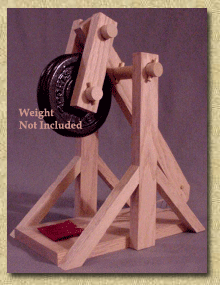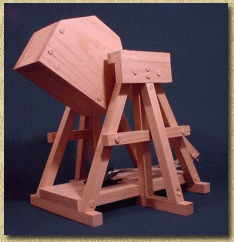|
|
History and Mechanics of
the Trebuchet
The Trebuchet from The Crossbow by Sir
Ralph Payne-Gallwey 1903

Fig. 211
- The Trebuchet
The arm is fully wound down and the tackle of the windlass is detached
from in. The stone is in the sling and the engine is about to be discharged
by pulling the slip-hook off the end of the arm.
N.B.- A Roman soldier is anachronistically shown in this picture.
The trebuchet was invented after the catapult and the time of the Romans |
The Trebuchet
from The Crossbow
by Sir Ralph Payne-Gallwey 1903
This engine was of much more recent invention than either the catapult
or the ballista of the Greeks and Romans. It is said to have been introduced
into siege operations by the French in the twelfth century. On the other
hand, the catapult and the ballista were in use before the Christian era.
Egiclio Colonna gives a fairly- accurate |
| description of the trebuchet and writes of it about 1280 as though
it were the most effective siege weapon of his time.
The projectile force of this weapon was obtained from the terrestrial
gravitation of a heavy weight, and not from twisted cordage as in the catapult
and balista. |
| From about the middle of the thirteenth century,
the trebuchet in great measure superseded the catapult. This preference
for the trebuchet was due to the fact that it was able to cast stones of
300 lbs. and more in weight or five or six times as heavy as those which
the largest catapults could project.
The stones of 50 to 60 lbs. thrown by siege catapults would no doubt
destroy towers and battlements, as the result of the constant and concentrated
bombardment of many engines. One huge stone of 300 lbs., as slung from
a trebuchet, would however shake the strongest defensive |

Fig. 212
- The Action of The Trebuchet
A. The arm pulled down and secured by the slip-hook previous to unhooking
the rope of the windlass. B. The arm released from the slip-hook and casting
the stone out of its sling. C. The arm at the end of its upward sweep.
|
| masonry and easily break through the upper parts of the walls of a
fortress.
The trebuchet was essentially an engine for destroying the defences
of a fortification , so that it might be entered by means of scaling ladders
or in other ways. From experiments with models of good size and from other
sources I find that the largest trebuchets those with arms of about 50
ft. in length and counterpoises of about 20,000 lbs. - were capable of
slinging a Stone 300 lbs. in weight to a distance of 300 yards, a range
of 350 yards being in my opinion more than these engines were able to attain.
The trebuchet made by order of Napoleon III., and described in his '
Etudes sur l'artillerie,' had an arm 33 ft. in length with a counterpoise
of 10,000 lbs. weight to work it. This machine projected a 50 lb. cannon-ball
200 yards, but was so lightly constructed that its full power could not
be safely applied. |

Fig. 213
- A Trebuchet with its Arm Being Wound
Down
Criticism.- Here we have a trebuchet with an arm at least 60 ft.
in length. An engine of such immense sizes as this would require a score
of men at its windlass instead of a couple. The heavy stone was placed
in the great sling of thick netting which is suspended to the end of the
arm. The sling was identical in its action with the one given in fig. 212. |
In a book on ' Experimental Philosophy,' by J.T.
Desaguliers, 1734 a curious and interesting old work on mechanical effects,
the author gives a detailed calculation of the power of a trebuchet, together
with plans of the engine as constructed from the writings of Vitruvius.
These drawings are, however, inaccurate, and though Desaguliers' conclusions
are exact, he only allows the trebuchet a counterpoise of 2,000 lbs. which
would be far too light a weight to be of any service in an engine of the
kind. |
| The trebuchet is sometimes depicted in medieval books with an arm like
that of a catapult (i.e. with a hollow in the end of the arm in which
to rest the stone), and without a sling , but this is incorrect.
The trebuchet always had a sling in which to place its missile.The sling
doubled the power of the engine and caused it to throw its projectile twice
as far as it would have been able to do without it.
It was the length of the arm, when suitably weighted with its counterpoise,
which combined with its sling gave power to the trebuchet. Its arm, when
released, swung round with a long easy sweep and with nothing approaching
the velocity of the much shorter arm of the catapult.
The weight of the projectile cast by a trebuchet was governed by the
weight of its counterpoise. Provided the engine was of sufficient strength
and could be manipulated, there was scarce a limit to its power. |
| Numerous references are to be found in medieval
authors to the practice of throwing dead horses into a besieged town with
a view to causing a pestilence therein, and there can be no doubt that
trebuchets were employed for this purpose. As a small horse weighs about
10 cwt., we can form some idea of the size of the rocks and balls of stone
that trebuchets were capable of slinging.
When we consider that a trebuchet was able to throw a horse over the
walls of a town we credit credit the statement of Stella who writes ‘that
the Genoese armament sent against Cyprus in 1373 had among other great
engines one which cast stones of 12 cwt.’ |

Fig. 214
-
Front and Side View |
| Villard de Honnecourt describes a trebuchet that had a counterpoise
of sand the frame of which was 12 ft. long, 8 ft. broad, and 2 ft. deep.
That such machines were of vast size will readily he understood.
Leonardo da Vinci described a trebuchet for defense of a fortification
and a study of sling release in his notebooks. |

Fig. 215
- Trebuchets Throwing Barrels Filled With Earth Into The Ditch Outside
A Fortress So As To Enable The Besiegers To Pass Over It And
Apply Their Scaling Ladders To The Walls.
Criticism - A very elaborate and fanciful drawing. The counterpoise
of the nearer engine could not swing back between the uprights, and it
and the other engine would each require at least six men to work the windlasses.
The barrels would not be projected 30 yards and the men working the
engines would be slain by the archers on the battlements of the besieged
fortress. |
For instance, twenty-four engines taken by Louis
IX at the evacuation of Damietta ill 1249, afforded timber for stockading
his entire camp ;3 a trebuchet used at the capture of Acre by the Infidels
in 1291, formed a load for an hundred carts ; 4 a great engine that cumbered
the tower of St. Paul at Orleans and which was dismantled previous to the
celebrated defence of the town against the English in 1428-9, furnished
twenty six cart loads of timber.
All kinds of articles besides horses, men, stones and bombs were at
times thrown from trebuchets. Vassaf records 'that when the garrison of
Delhi refused to open the gates to Ala'uddin Khilji in 1296, he loaded
his mangonels with bags of gold and shot them into the fortress, a measure
which put an end to the opposition.' |
| Figs 211, 212 & 214, explain the construction and working of the
trebuchet. |
Click
Here to View
Mobile Version
|
Save up to 50% with Multi-Plan Deals
|
| 2 Plans $19.95 FREE Shipping
- Save Over 30%
U.S. Orders Only |
|
| Do It Yourself Working Model Trebuchet Kit |

|
 Trebuchet
Kit
Trebuchet
Kit
Item
#TK
|
$75.00
Free
Shipping
U.S. Orders Only |

|
The trebuchet kit includes fully precut and drilled
frame parts, pins and axles, sling cord and sewn pouch, projectiles and
fully illustrated assembly and firing instructions.
Unlike the flimsy, snap together plywood trebuchet
kits, this all hardwood trebuchet kit does not require additional cutting,
trimming or shaping.
This DIY Trebuchet Kit requires only white carpenter's
glue and a few bar clamps (not included) to assemble.
Read
More > |
| Fully Assembled Working Model Trebuchet |

|

daVinci Trebuchet
Item # T4
|
$299.00
Free
Shipping
U.S. Orders Only
|

|
Inspired by the great war machines and siege catapults of Leonardo da Vinci
, this all Red Oak
hardwood trebuchet features
an open counterweight cabinet for range and trajectory adjustment.
Fire with an empty counterweight for indoor use, or add weight (nuts,
bolts, scrap lead, iron or steel, sand, or small rocks not included)
for increased range.
Individually crafted from cabinet-grade red oak, the da Vinci Trebuchet
stands 14 inches tall in the cocked position, 24 inches tall in the fired
position and will hurl a projectile up to 60 feet. Includes six projectiles
and fully illustrated instructions.
Read More > |
History and Mechanics of the Trebuchet
- The Trebuchet from The Crossbow by Sir Ralph
Payne-Gallwey 1903 |